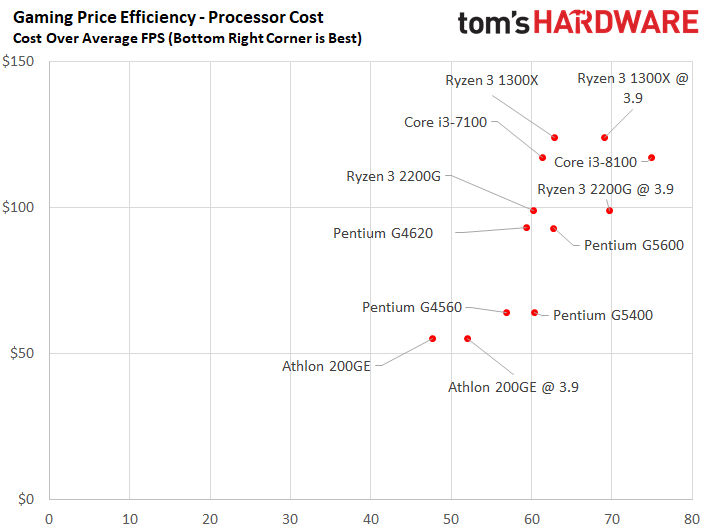AMD Athlon 200GE Review: Zen and Vega Get Cheap
Why you can trust Tom's Hardware
Conclusion
AMD and Intel both limit the capabilities of their cheapest CPUs to prevent enthusiasts on a budget from dipping down to low-end models and tweaking them to achieve higher performance. Features get deliberately disabled, cache gets shaved off, and clock rates are purposely lowered. It's also common to see ratio multipliers locked, especially by Intel. AMD is typically more accommodating of overclockers: up until now, all of its Zen-based processors were unlocked.
This made the Athlon 200GE's static 3.2 GHz clock rate somewhat surprising. At that frequency, AMD doesn't fare particularly well against Intel's faster Pentium chips. Really, AMD needs overclocking to compete. MSI and Gigabyte (so far) are doing the company a favor here by developing firmware updates that reverse AMD's lock, enabling frequencies approaching 4 GHz.
The Athlon's position is strengthened by Intel's inability to ship sufficient quantities of 14nm processors, causing shortages of Pentium CPUs that drive prices higher than they should be. Some of the Athlon 200GE's competition simply isn't available to purchase. If you're a budget-oriented builder shopping for something under $100 and the Pentiums aren't in stock, your decision becomes much easier to make.










It's only a bummer that, after overclocking, the Athlon 200GE is still slower than the Pentium family across our gaming suite. Then again, the Athlon is priced more like a Celeron than a Pentium, so you still end up with acceptable performance from an entry-level CPU. Matched up to a similarly low-end add-in card like AMD's Radeon RX 550 or Nvidia's GeForce GT 1030, the big deltas between host processors we saw aren't as apparent.
Where the Athlon 200GE shines is threaded workloads like Blender, HandBrake, and archive decompression. Those results also bode well for multi-tasking, which isn't a part of our benchmark suite, but does correspond to juggling multiple threads simultaneously. Even on a mainstream office machine, multi-tasking is common. Moreover, it's notable that the Athlon 200GE accelerates AVX instruction processing. Intel's Pentium CPUs lack this capability.
Overclocking the Athlon 200GE is simple, but we would like to see more options exposed to enthusiasts. Let us tune the Vega 3 engine's clock rate, for example, and open up higher memory data rates. Given the few knobs we had available, we squeezed an extra 9% out of the Athlon across our gaming suite using the thermal solution AMD includes as part of its package.
The Athlon 200GE is ~$10 cheaper than Intel's Pentium G5400, which is largely unavailable due to Intel's ongoing shortage of 14nm chips. The higher-end Pentium G5600 sells for ~$105, which is $20 above MSRP. Although those seem like small premiums, they're actually pretty significant as a percentage of what these low-end CPUs cost.
Get Tom's Hardware's best news and in-depth reviews, straight to your inbox.
Despite its value win, we'd rather see you snag a $100 Ryzen 3 2200G (our current Best Entry Level Pick) than the Athlon 200GE. It's simply a better processor, giving you two more CPU cores, 320 additional Stream processors, and the ability to overclock memory and graphics. The Athlon 200GE is a good chip at its price point, even at stock settings. But you're forced to accept too many trade-offs. While unofficial overclocking helps improve the Athlon's position, it isn't a cure-all.
MORE: Best Cheap CPUs
MORE: Intel & AMD Processor Hierarchy
MORE: All CPUs Content

Paul Alcorn is the Editor-in-Chief for Tom's Hardware US. He also writes news and reviews on CPUs, storage, and enterprise hardware.